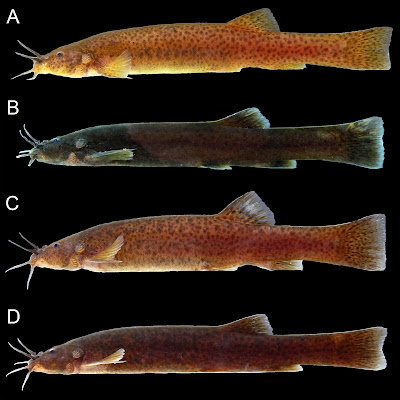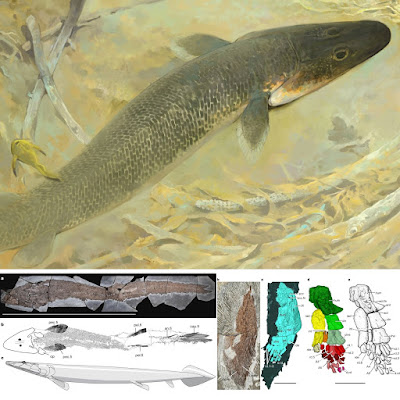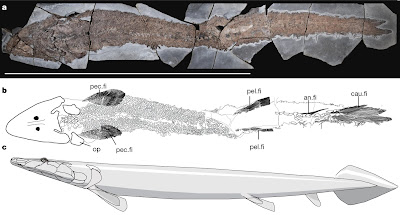[Most Recent Entries] [Calendar View]
Friday, March 20th, 2020
| Time | Event | ||||
| 10:05a | [Ichthyology • 2020] Trichomycterus lauryi • Taxonomical Study of Trichomycterus (Siluriformes: Trichomycteridae) from the Ribeira de Iguape River Basin reveals A New Species Recorded in the early 20th Century
Abstract A new species of Trichomycterus endemic to the Ribeira de Iguape River basin, southeastern Brazil, was studied based on morphological and molecular evidence. This species had an outer layer of coloration composed of scattered, round, black or dark‐brown spots smaller or equivalent in size to the circumference of the eye; eight pectoral‐fin rays; 28–29 opercular odontodes; 54–56 interopercular odontodes; and supraorbital line of the laterosensory system not interrupted, with pores s2 absent. Two other species of Trichomycterus from the Ribeira de Iguape River basin are recorded, and their taxonomic status is discussed: Trichomycterus alternatus and Trichomycterus jacupiranga were not differentiated using molecular analysis but may be consistently distinguished based on morphology. The phylogenetic relationships of the co‐occurring species, T. alternatus and Cambeva zonata, were inferred using mitochondrial data, reinforcing the taxonomic status of these recently revised species that have a complex taxonomy. In addition, a new combination for Trichomycterus taroba with its inclusion in the genus Cambeva is recommended. Keywords: Cambeva zonata, colour pattern, incomplete lineage sorting, Trichomycterinae, Trichomycterus alternatus Trichomycterus lauryi sp. nov. Etymology: The specific epithet “lauryi” was given in honour of Laury João Donin (in memoriam), Laura Donin's father.
Laura M. Donin, Juliano Ferrer and Tiago P. Carvalho. 2020. Taxonomical Study of Trichomycterus (Siluriformes: Trichomycteridae) from the Ribeira de Iguape River Basin reveals A New Species Recorded in the early 20th Century. Journal of Fish Biology. DOI: 10.1111/jfb.14278 | ||||
| 10:09a | [Paleontology • 2020] Elpistostege and the Origin of the Vertebrate Hand
Abstract The evolution of fishes to tetrapods (four-limbed vertebrates) was one of the most important transformations in vertebrate evolution. Hypotheses of tetrapod origins rely heavily on the anatomy of a few tetrapod-like fish fossils from the Middle and Late Devonian period (393–359 million years ago). These taxa—known as elpistostegalians—include Panderichthys, Elpistostege and Tiktaalik, none of which has yet revealed the complete skeletal anatomy of the pectoral fin. Here we report a 1.57-metre-long articulated specimen of Elpistostege watsoni from the Upper Devonian period of Canada, which represents—to our knowledge—the most complete elpistostegalian yet found. High-energy computed tomography reveals that the skeleton of the pectoral fin has four proximodistal rows of radials (two of which include branched carpals) as well as two distal rows that are organized as digits and putative digits. Despite this skeletal pattern (which represents the most tetrapod-like arrangement of bones found in a pectoral fin to date), the fin retains lepidotrichia (fin rays) distal to the radials. We suggest that the vertebrate hand arose primarily from a skeletal pattern buried within the fairly typical aquatic pectoral fin of elpistostegalians. Elpistostege is potentially the sister taxon of all other tetrapods, and its appendages further blur the line between fish and land vertebrates.
Richard Cloutier, Alice M. Clement, Michael S. Y. Lee, Roxanne Noël, Isabelle Béchard, Vincent Roy and John A. Long. 2020. Elpistostege and the Origin of the Vertebrate Hand. Nature. DOI: 10.1038/s41586-020-2100-8 Ancient fish fossil reveals evolutionary origin of the human hand |
| << Previous Day |
2020/03/20 [Calendar] |
Next Day >> |












